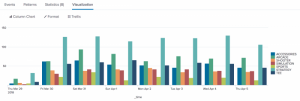
Splunk Time chart is applied to certain field for producing a chart. Where the time (T) used as X-axis. You can select them as Split-by field. Where a Field splits every distinct option. Known as Series in blueprint. When you use an Eval Expression. The Split by Clause is needed, with the limited options. You can select certain series of filtering. Options like this, they were ignored, if you select an explicit where-clause or if you set certain limit=0, no series filtering happens.

Splunk Time Chart
It can be explained in an easy way. Think that you have large sets of Data, you need to specify, how much revenue and Sales were generated on monthly basis. It also used for analyzing operations and performance results. It equally increased or decreased with over date.
Generally, Splunk stats, time, graph terms to visualization of any type of Information that is with respect to the date sketch. Data that showed in column blue prints, that which is sectioned by X-axis, that is every date field, the y-axis is the variable axis.
Stats
known as reporting Command, which used to show information in table method. You can utilize many fields for designing a table.
Chart
The chart displays the information in the form of area graph, line, bar. It offers the capability for generating Pie table.
Time Chart
It accepts you to look at the line graphs and bar. However, the Pie blueprint were Not Implementable. In date chart, it takes one field that is as X-axis fixed as date.
How to design a Time based Chart.
Time chart Generates a table of Summary Statistics. In the same way, this table used for formatting a blueprint Visualization. Here Your Data plotted on X-axis, this is why it is a time field. You have to utilize the day graph command for displaying statistical trends and many more. You can Split Information into another field and a graph separates it. In the same way, date sketch visualizations were usually column graphs, area and line with splunk spath.
When we use Time blueprint rule, the x-axis shows the date. Y-axis can be other tract value, that is the Count of Statistical calculation in the patch value.
Stats and Event Stats Command
The Event starts command work in the same manner as Stats request. That is Except the Aggregation results that added inline for every Event. As a matter of fact, aggregation that related to every event.
We can explain them with split clause method.
Here, we have to utilize totally by Stats order. That you have to include them in a Split by clause method. For Instance, the below report don’t need more information with Splunk join.
Sourcetype=access_combined | Stats avg(kbps)
It offers you average KBPS for every event, with a set of Source type that accesses combined in one single value. As a matter of fact, Output column blueprint has only one column.
Especially, When you break the report, by a split test. The Splunk share price produce a report, that which break with stats by field. The Following report produces a column blueprint.
Sourcetype=access_combined | stats avg(kbps) by host.
Example: In the same way it shows how to design a report, that shows you CPU working with Splunk Rex examples. In a Descending Order.
index=_internal "group=pipeline" | stats sum(cpu_seconds) by processor | sort sum(cpu_seconds) desc
Rare and Top Commands
Generally a top rule comes to most specific value in returned event. Rare request returns to certain specified events. Both order share similar syntax. At the same date, If you do not have a certain specified limit. Inbuilt number of values showed.
Example
Below example shows source ports of a security system.
Sourcetype=firewall action=deny | rare src_port
Chart Command
To illustrate, graph command returns your result in information design. That guide visualization of your information series, just like a sketch like. Column, area, and pie table.
Not to mention time graph rule, uses the _time default patch as axis, the graph designed with sketch request. Which use an arbitrary field like X-axis. With the guidance of table order. You can use total keyword for determining which tract take X-axis, by 24-hour time chart.
Example
In particular, It uses web access information for showing the average count of visitors
Sourcetype=access_* | Chart avg(clientip) over Date_wday